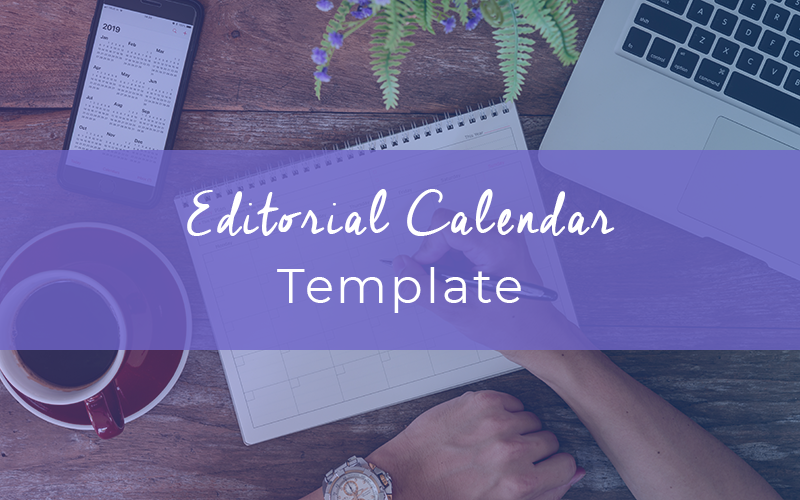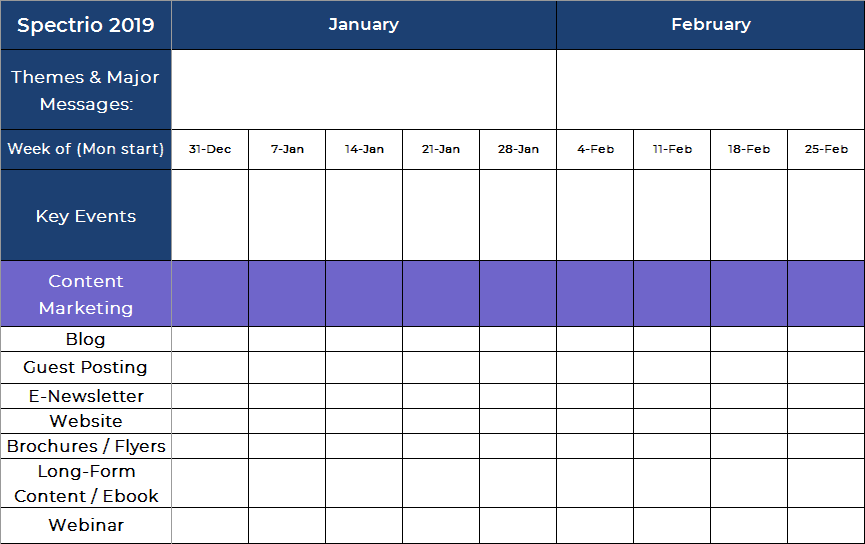
If content creation leaves you feeling overwhelmed and disorganized, you aren’t alone. Many businesses and brands struggle with maintaining a streamlined and systematic approach to content organization and planning — until they start using an editorial calendar.
What’s an Editorial Calendar?
An editorial calendar is often associated with blogging. People associate it with publishers using a guide to schedule and plan their upcoming blog posts.
But an editorial calendar can — and should — be so much more than that.
An editorial calendar is not just an outline for a blog. It’s a plan for every piece of marketing content that a business creates both online and offline. It’s incredibly useful to help you see the “big picture” of customer touch-points across your brand: whether you are a marketing team of one or 1,000.

What’s Included in an Marketing Editorial Calendar?
An editorial calendar includes a schedule for all marketing and internal messaging content. It may also include sections for the following types of material and platforms.
Themes and Upcoming Dates. To develop relevant and cohesive content topics, an editorial calendar should include a section for declaring themes, major messages, and events. Highlighting upcoming events allows marketers to plan ahead, and setting monthly or weekly themes offers guidelines that lead content creators in the right direction.
Content Marketing. This is the type of content that marketers would expect to find in an editorial calendar as it is more “editorial” focused. Most of this content is online, but include any of your content created to provide value to an audience while subtly promoting services, products, and offerings.
- Blogs
- Guest posts
- E-newsletter
- Website
- Brochures / Flyers
- Long form content / Ebooks
- Webinar
- Podcast
- Customer testimonials
Social Media. An editorial schedule for social media posts may include the actual message that will be shared, or it may simply include the theme or topics that should be mentioned within a time-frame (i.e. weekly or monthly themes). This portion of your editorial calendar should include organic posts (that are free, not paid ads). Depending on your audience, you may include a plan for one or more of the following platforms.
- YouTube
- Snapchat
- Slideshare
- Etc.
Paid Advertising. Your editorial calendar should coordinate and track all of your marketing messages – especially the advertisements. Use your schedule to track the production and publishing dates of all of your ad campaign content. That way, when you see a boost in business transactions, you can tie it back to related marketing and advertising activity.
- Print ads
- Video ads
- Mailers / Out-of-home Advertising
- Billboards
- Search engine marketing
- Paid social media
On-Property Signage. Even if your product is displayed on your property, it can easily become overlooked, as just another part of the background. Breathe new life into your physical store by adding a section to your editorial calendar that includes content on static and digital signage displays. When you consider what to include on these signs, incorporate the message themes from Content, Social, and Paid channels.
- Waiting area
- Exam rooms / Private customer areas
- Reception / Check-out
- Service counters
- Elevators
- Showroom
- Exterior signage
- Employee break room
On-Hold Marketing. It’s easy to overlook out-dated messaging right in front of you — which means it’s even easier to overlook messaging when you can’t see it. On-hold messaging is often neglected because it is out of sight, out of mind. So, schedule dates to regularly change your on-hold message using your editorial calendar.
- “Did you know?” facts and educational content
- Special offers and promotions
- Music themes that match the season
Overhead Messaging and Music. As seasons and your promotions change, make sure that your overhead music and messaging reflects that. Use your calendar to schedule dates to change the themes and information in your in-store overhead messaging.
- Short “Did you know?” facts or educational content
- Special offers and promotions
- Musical styles to match the shopping experience
- Reminders to check out other brand channels (e.g. “Like us on Facebook!)
Community Relations and PR. Your content also includes the messages you share with your community through outreach and in-person events. Include all of the themes, dates, and messages your business will release as it relates to public relations.
- On-property events / Open houses
- Press releases
- Speaking events
- Conferences / Tradeshows
- Community sponsorships
When you list all of the types of marketing content that your business creates, it’s easy to see why managing content feels complicated. But with an editorial calendar, you can put all of the pieces of the puzzle in one place and organize and optimize your content strategies.

Who Should Use a Marketing Editorial Calendar?
While an editorial calendar may sound like something reserved for publishing and media businesses, all types of companies and organizations can benefit from this schedule.
Whether you realize it or not, every business is a publishing group. From print marketing materials to ads on television to website content — all businesses produce some type of content.
Therefore, all businesses should use an editorial calendar!
Every company can benefit from an organized content plan and schedule. And it’s not just useful for their marketing teams.
Multiple departments can use the schedule. Businesses should involve multiple members of their team in the creation and production of the editorial calendar. Sales, marketing, and PR team members can all benefit from seeing and using a calendar of content. Customer-facing employees should be especially familiar with your business’s messages. Don’t keep them in the dark!
How Do You Use An Editorial Calendar?
When you have an editorial calendar, it makes your marketing management easier in a variety of ways. You can:
- Come up with content ideas
- Choose the right platforms for publishing/posting
- Create strategic promotions
- Keep multiple members of a team on the same page
- Plan in advance for holidays and events
- Avoid losing or misplacing content
- Stay on a publishing schedule
- Identify repurposing opportunities
- Ensure that you never forget to update time-sensitive content
How Do You Create an Marketing Editorial Calendar?
If you are ready to start creating your editorial calendar right now — we have you covered.
We created an editorial calendar template that includes all of the sections mentioned in this post. Download the free template and start building an editorial calendar and organizing your brand’s content today.